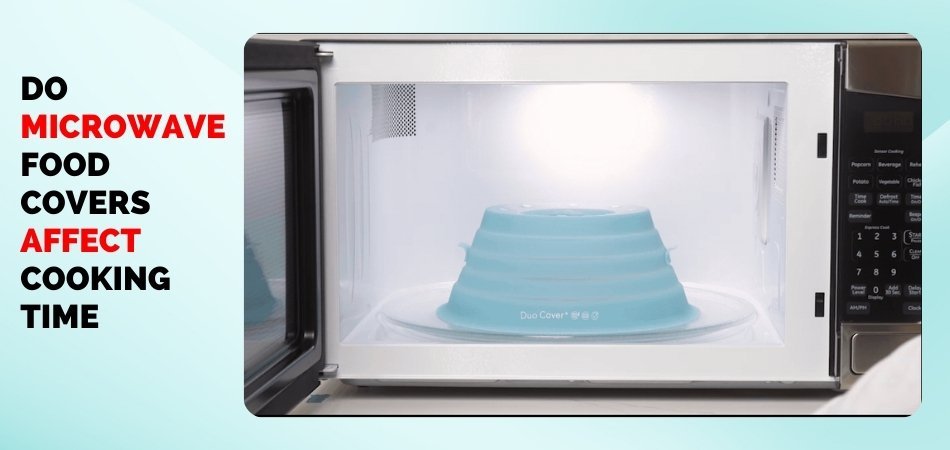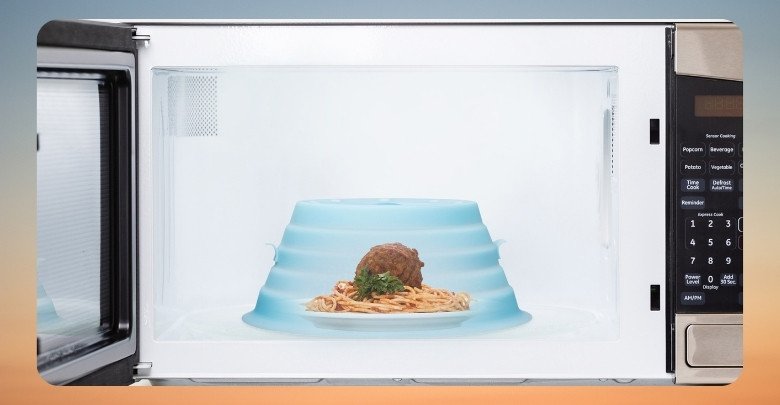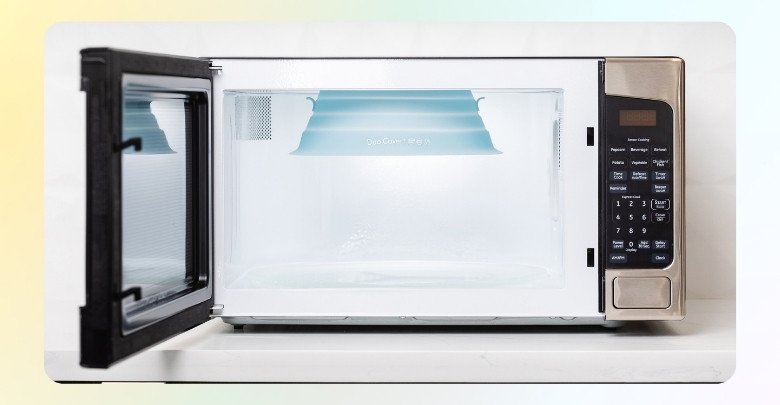Cooking is a common part of daily life, and with busy schedules, many turn to the microwave for quick and convenient meals. To make microwave cooking even simpler, accessories like microwave food covers have become popular for their ease of use. That brings us to a common question: Do microwave food covers affect cooking time?
Yes, microwave food covers can affect cooking time. They help trap steam and heat, allowing food to cook more evenly and often faster. Covers also prevent splatters, keeping the microwave clean. However, overly tight covers may cause uneven heating or overcooking, so venting is important for best results.
If you would like to learn more about the impact that microwave covers have on your cooking results, please keep reading.
Do Microwave Food Covers Affect Cooking Time? (Exploring the Effects)
Yes, microwave food covers do affect cooking time. These covers help trap heat and steam, making your food cook faster and more evenly. When steam stays close to the food, it creates a warmer cooking environment that speeds up the heating process. This is especially helpful when you’re short on time or reheating leftovers quickly.

Not only do they reduce cooking time, but they also help food cook more evenly throughout. Uneven heating is a common issue in microwaves, especially with dense or thick meals. Using a cover helps prevent cold spots and improves the texture of your food. Some products, like duo cover also come with venting features that let out excess steam to avoid overcooking.
Another benefit of using food covers is that they keep your microwave clean by stopping messy splatters. No one likes scrubbing dried sauce off the microwave walls after every meal. A cover saves time on cleaning while keeping the inside fresh and odor-free. Plus, it adds a layer of safety by preventing hot liquid from popping out during cooking.
However, if the cover seals too tightly, it might trap too much steam and cause overcooking. That’s why using a vented cover or slightly lifting the lid is important. This way, steam escapes in small amounts and keeps food from getting too soggy or dry. In short, the right cover improves cooking results and makes microwave use safer and more efficient.
How to Properly Use a Microwave Food Cover at Home?
The use of a microwave food cover might seem simple, but there are a few steps to follow. A cover can improve cooking time and keep your microwave clean, but it’s important to use it properly. Let’s explore how to get the best results:
Choose the Right Cover
Not all covers are made the same. Some are designed with vents, while others are solid. It’s important to pick the one that suits your food. A vented cover helps steam escape, while a solid cover keeps moisture in. Both types can be helpful, but knowing when to use each is key.
Ensure Proper Venting
Always make sure your cover has a vent if you’re cooking food that needs steam to escape. Without vents, the pressure inside the cover can build up, causing uneven cooking or even making your food soggy. If your cover doesn’t have vents, try lifting one side to let the steam out. This way, you get the right texture and avoid overcooking.
Don’t Seal Too Tight
It’s tempting to press the cover down tightly, but it can lead to problems. A tight seal can trap too much moisture, which might cause food to overcook or get too mushy. Leave a little space between the cover and food for air to circulate. This allows your food to cook evenly and prevents it from getting soggy.
Use the Right Size Cover
Using a cover that’s too small or too large can cause problems. If it’s too small, it won’t cover your food completely, and if it’s too big, it might not heat properly. One of the healthiest microwave covering methods is ensuring that the cover fits snugly over your food without touching it. This ensures that the food cooks evenly and the cover does its job.
Keep It Clean
Like any other kitchen tool, your microwave food cover needs cleaning. After every use, wash it with warm, soapy water to remove any food particles. A clean cover helps prevent smells and keeps your food tasting fresh. It also ensures that your microwave stays spotless.
Avoid Using Plastic Wrap
While plastic wrap might seem like an easy alternative, it’s not always the best option. It can stick to the food and make a mess. Plus, it doesn’t let steam escape properly, which can lead to uneven cooking. It’s better to stick with a microwave-safe cover that’s designed for the job.
Check for Microwave Safety
Make sure the cover you use is microwave-safe. Some materials can melt or release harmful chemicals when heated. Always check the label to ensure the cover is safe for use in the microwave. This keeps your food safe and avoids any potential damage to the microwave.
Test Different Cooking Times
Sometimes, the cover might affect cooking times slightly. It’s a good idea to test different times when using the cover to find what works best for your microwave. Each microwave is different, and the cover might change how fast your food cooks. Once you know the right time, cooking will be quicker and easier.
Should You Always Use a Cover When Microwaving Food?
Yes, you should use a cover when microwaving food, but it depends on what you’re heating and how you do it. Covers help stop food from splattering and keep your microwave cleaner after every use. They also trap heat and steam, which helps the food cook faster and more evenly. However, there are times when using a cover isn’t always the best choice for certain foods.

Some foods need to release steam while heating, or they might get too soggy or overcooked inside a sealed container. It’s a good idea to leave a small vent or gap when covering food to let the steam escape. This helps balance the heat and avoids making your food too wet or rubbery. Always check the type of food and how it reacts before fully covering it in the microwave.
Using the right cover also makes a big difference in how well your food turns out after heating. Microwave-safe covers or lids are best because they are made for that purpose and are safe to use. Avoid using things like plastic wrap or regular lids that don’t allow steam to escape. When used correctly, a good cover can save time, keep your food tasty, and make cleanup much easier.
What Happens When You Use Non-Microwave Safe Covers?
The use of non-microwave-safe covers might seem harmless, but they can cause a lot of problems. It’s important to know what happens when you use the wrong cover in the microwave. Keep reading to discover the risks and how to avoid them.
Can Melt or Warp
You might have trouble with your covers if they aren’t microwave-safe. Heat from the microwave can be too much for regular plastic or thin materials. If a cover melts, it can stick to your food and ruin it. This also makes a big mess that’s hard to clean. Always check the cover says “microwave-safe” before using it.
Can Release Chemicals
Some plastic covers may let out harmful chemicals when they get hot in the microwave. Understanding plastic food cover safety in the microwave is important to avoid these risks. These chemicals can mix with your food, which is not good for your health. You can’t always see or smell them, so it’s easy to miss them. That’s why it’s safer to use covers made for microwave use.
Fire or Sparks Risk
Covers with metal parts or shiny designs can cause sparks in the microwave. This can lead to small fires or damage inside your microwave. It’s really risky and can break your appliance. Always avoid any covers with foil, metal, or shiny paint. A simple microwave-safe cover is always a better and safer choice.
Food Cooks Unevenly
Non-microwave safe covers may block heat or trap too much steam. This can make food heat unevenly, leaving parts too hot or still cold. It also affects the taste and texture of your meal. A good cover helps food heat properly without making it soggy. So picking the right cover helps the food turn out better.
Smells and Stains
Some covers can soak up food smells or leave stains when used in the microwave. These smells can stick and mix with future meals. Over time, your cover might start to look bad or smell weird. Microwave-safe ones are built to resist stains and odors. They stay cleaner and last longer with regular use.
Hard to Clean
Covers not made for microwave use often become sticky or tough to wash after heating. The material might break down, making it feel rough or greasy. Scrubbing them takes extra time and effort. Microwave-safe covers are usually easier to rinse and wipe. Keeping them clean is quicker and less frustrating.
Investing in a High-Quality Microwave Cover: Is It a Good Idea?
Yes, investing in a high-quality microwave cover is a good idea. It keeps your food clean, heats it better, and protects your microwave. A good cover lasts longer and saves you from cleaning messes every day. Let’s look at what makes one worth buying.

Strong and Durable
High-quality microwave covers are made from strong materials that don’t crack or melt easily. They can handle heat without changing shape or color. Unlike cheap ones, they don’t wear out after a few uses. You can use them again and again without any problems. They’re built to last and save you money over time.
Easy to Clean
A good microwave cover is super easy to wash. Most of them are dishwasher-safe or can be rinsed quickly under running water. They don’t hold on to food smells or stains. This makes them more hygienic and better for everyday use. Cleaning them takes just a few seconds.
Keeps Food Safe
High-quality covers are made from safe, microwave-friendly materials. They don’t release harmful stuff into your food when heated. This makes a big difference when it comes to health. You can warm up meals without worrying about plastic melting or food contamination. Safety always comes first with the right cover.
Better Heating Results
Good covers help food heat up evenly and faster. They hold in just the right amount of steam, so the food stays moist and warm. No more cold spots or dry edges. The cover helps spread the heat evenly around your food. That means better taste and texture in every bite.
Protects Your Microwave
Food splatters are common, but the right cover can stop them. It keeps sauces and liquids from messing up the microwave walls. This saves you time and effort on cleaning. Your microwave also stays smelling fresh and looks clean. Less mess means a longer life for your microwave.
Smart Features
Many high-quality covers come with vents, handles, or folding designs. The vents help control steam, and the handles make it easier to lift without burning your hands. Some even collapse flat for easy storage. These small features make a big difference. They add comfort and make microwave use even easier.
FAQs About Do Microwave Food Covers Affect Cooking Time?
There are numerous questions about how microwave food covers affect cooking time and results, even though they may seem simple. Listed below are some common questions and answers that will assist you in using your microwave more effectively.
Why Does My Food Still Dry Out With a Cover?
Food can dry out even with a cover if it’s overcooked or if the cover isn’t vented properly. Trapped steam may not circulate effectively, especially with thick or dry foods. Try adjusting cooking time and ensure your cover allows some steam release.
Can I Use a Microwave Cover in a Convection Microwave?
Yes, you can use a microwave cover in a convection microwave, but only during microwave-only settings. Convection mode uses hot air and may damage plastic covers. Always check the cover’s heat resistance and avoid using plastic during convection cooking unless clearly labeled.
Are Vented Microwave Covers Better Than Solid Ones?
Vented microwave covers are generally better because they let out extra steam, which prevents overcooking and sogginess. Solid covers trap too much moisture and can cause uneven results. A vented design offers a good balance between keeping heat in and releasing pressure.
What’s the Best Shape for a Microwave Cover?
A dome-shaped cover is ideal because it allows steam to circulate better around the food. Flat covers can press against the food, especially if the dish is full. Dome covers also offer more room for steam buildup and better heating performance overall.
Can Microwave Covers Be Used for Storing Food?
Some microwave covers can double as food storage lids, but not all are designed for that. Covers used for cooking should be cleaned before storing food to avoid cross-contamination. It’s best to use separate lids designed specifically for safe food storage.
Are There Microwave Covers With Built-In Timers?
Microwave covers with integrated timers or color-changing indicators are available in high-end models. While not common, these smart features help avoid overcooking. They’re especially useful in busy kitchens or when heating food with exact timing needs.
Bottom Line
Microwave food covers may seem like a small kitchen tool, but they make a big difference in everyday cooking. They help food heat faster, reduce splatters, and improve cooking results. Choosing the right cover with proper venting helps avoid soggy or uneven meals.
If you are still unsure about, do microwave food covers affect cooking time? Yes, they do—by trapping steam and heat, they help cook food more evenly and often more quickly. Using microwave-safe, high-quality covers also keeps your microwave cleaner and protects your food from harmful materials.
Whether you’re reheating leftovers or preparing a quick snack, the right cover saves time and effort. In the end, a good microwave cover isn’t just helpful; it’s a smart, practical choice for better and safer meals.






